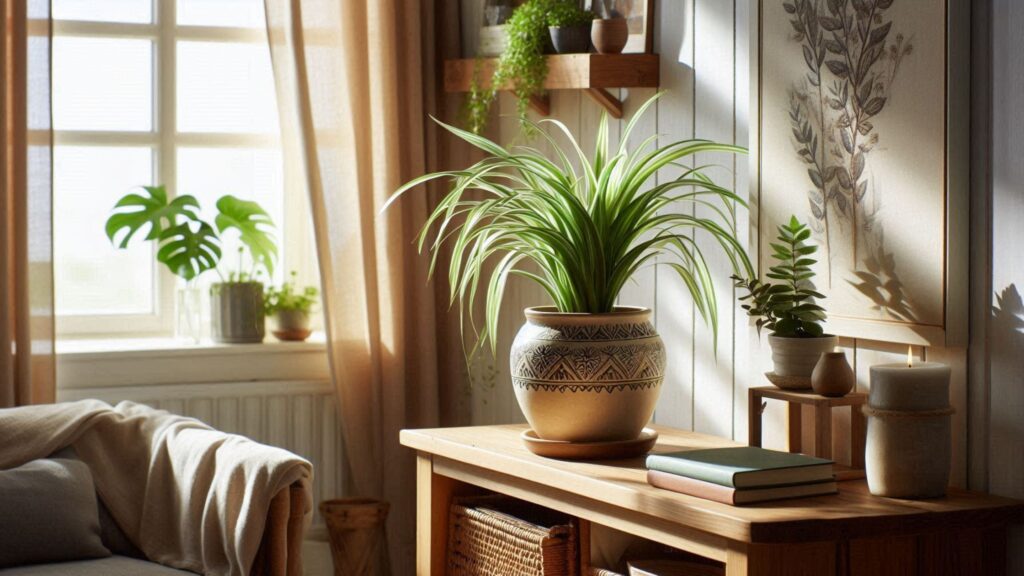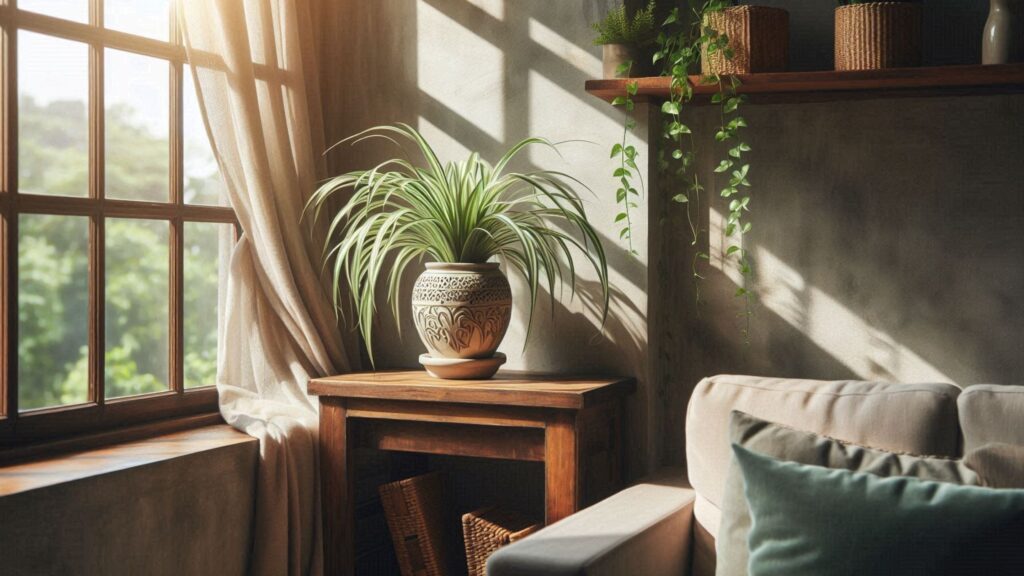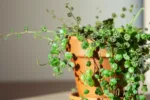Spider plants, scientifically known as Chlorophytum comosum, are popular indoor plants cherished for their elegant foliage and easy maintenance. spider plants are low-maintenance, forgiving plants perfect for beginners and seasoned indoor gardeners alike. They can thrive and bring beauty to any indoor space with proper care.
Types of Spider Plant
- Variegated Spider Plant
- Bonnie Spider Plant
- Reverse Variegated Spider Plant
- Airplane Spider Plant
- Zebra Spider Plant
- Hawaiian Spider Plant
- Ocean Spider Plant
- Fire Flash Spider Plant
- Bichetii Grass Spider Plant
- Green Shamrock Spider Plant

Benefits of Spider Plant
Spider plants are popular houseplants for a reason! Some of their well-known advantages are as follows:
Air Purification: Spider plants are great natural air cleaners. They absorb common toxins and pollutants found indoors, like formaldehyde, benzene, and toluene, according to a NASA clean air study.
Low Maintenance: Spider plants are known for being easy to care for. They thrive in a variety of lighting conditions and don’t require frequent watering.
Safe for Pets and Children: Unlike some houseplants, spider plants are non-toxic to both cats and dogs according to the ASPCA
Easy Propagation: Spider plants produce baby siderites on long runners, which can be easily repotted to create new plants. This makes them a great choice for those who want to share the greenery with friends and family
tune share and share
Disadvantages of Spider Plant
While spider plants are fantastic houseplants with many benefits, there are a few things to consider:
Mild Toxicity (for pets): While generally considered non-toxic, spider plants contain saponins, which can cause mild stomach upset or vomiting if ingested by pets in large quantities.This is especially true for curious cats who might find the dangling spiderettes tempting to chew on.
Fast Growth (can be a benefit or drawback): Spider plants are vigorous growers and can quickly fill their pot with foliage. This can be a positive, but it might also require repotting more often than some slower-growing plants. If you prefer a more compact houseplant, a spider plant might not be the best choice.
Pest Resistance: Although spider plants are typically pest-resistant, they are sensitive to mealybugs, aphids, and spider mites, particularly in dry or dusty circumstances. To maintain your plant healthy, you must do regular inspections and administer proper treatments.
Browning Tips: This is a common cosmetic issue with spider plants and not necessarily a sign of serious trouble. The tips of the leaves can turn brown due to underwatering, overwatering, low humidity, or mineral build-up from tap water. Adjusting watering habits and using filtered or rainwater can help prevent this.
Spider Plant Care
Spider plants are known for being easy to care for, but here’s a breakdown of their key needs to keep them thriving:
Light: Spider plants prefer bright, indirect sunlight. Steer clear of the intense sun, since it might burn the foliage. They can tolerate lower light conditions but may grow slower and have less vibrant foliage.
Water: Water your spider plant when the top inch of soil feels dry to the touch. Don’t overwater; this can cause root rot. Empty any excess water that drains out of the pot after watering. Consider using filtered or rainwater to avoid mineral build-up on the leaves, which can cause brown tips.
Temperature and Humidity: Spider plants prefer warm temperatures between 60-80°F (15-27°C). They thrive in moderate to high humidity levels but will tolerate average household humidity. You can mist the plant occasionally or group it with other plants to increase humidity.
Fertilizer: During spring and summer, you can fertilize your spider plant once a month with a balanced houseplant fertilizer diluted to half strength. Avoid fertilizing in winter when the plant is not actively growing.
Repotting: Spider plants are fast growers and may need to be repotted every 1-2 years into a slightly larger pot with fresh potting mix.
Propagation: Spider plants produce baby spiderettes on long runners. These can be easily separated and repotted to create new plants.
Propagation of Spider Plant
Propagating spider plants (Chlorophytum comosum) is indeed easy and can be done through various methods. One of the simplest ways is by using the plantlets, also known as spiderettes, that develop on long, trailing stems. Here’s how to propagate spider plants easily.
Locate Plantlets: Spider plantlets typically develop at the ends of long, arching stems. These plantlets are miniature versions of the parent plant and have small roots already forming.
Prepare Pots: Prepare small pots or containers filled with well-draining potting soil. You can use the same potting mix recommended for mature spider plants.
Detach Plantlets: Once the spiderettes have grown to a reasonable size and have developed some roots (usually about 2-3 inches long), carefully detach them from the parent plant. You can use clean scissors or simply twist them off gently.
Plant the Spiderettes: Plant each spiderette in its own pot, making sure to bury the roots in the soil. You can plant multiple spiderettes in the same pot if desired, but ensure they have enough space to grow.
Provide Care: After planting, water the soil lightly to settle it around the roots. Place the pots in a bright, indirect light location. Keep the soil evenly moist but not waterlogged to encourage root growth.
Monitor Growth: Over the following weeks, monitor the newly planted spiderettes for signs of growth. They should start to establish roots and develop new leaves.
Transplanting: Once the spiderettes have grown larger and established a healthy root system, they can be transplanted into larger pots if needed. Follow the same care guidelines for mature spider plants.
Repotting of Spider Plant
Repotting a spider plant is an excellent method to maintain its health and promote development. To assist you with the procedure, below is a step-by-step guide:
Choose the Right Time: The ideal time to repot a spider plant is while it’s actively growing, which is in the spring or early summer. This allows it to become established in its new container prior to winter.
Select a New: PotGo for a pot that’s just a tad bit bigger than your existing one. To avoid waterlogging, which can cause root rot, make sure it has drainage holes.
Get the New Pot Ready: Add fresh potting mix to the bottom of the new pot. A mixture of peat moss, perlite, and compost works well since spider plants like well-draining soil.
Plant removal from its current pot: To dislodge the plant, gently tip the pot on its side and tap the bottom. Using your hand to hold the plant’s base, gradually slide it out once it is loose.
Evaluate the Roots: Examine the plant’s roots. Gently loosen them with your fingertips if they are tightly packed or surrounding the pot. In the newly acquired pot, this promotes robust root development.
Plant in the New Pot: Position the plant in the middle of the new pot and cover the entire root system with potting mix surrounding it. To facilitate watering, allow approximately one inch of space to exist between the top of the soil and the pot’s lip.
Water well: Water the plant well to aid in settling the dirt and hydrating the roots. A free flow of water from the pot’s bottom should be ensured.
Place in an Appropriate Spot: Give your recently repotted spider plant a place to grow that will provide it with bright, indirect sunshine. It should not be placed in direct sunlight as this might burn the foliage.
Monitor and Care for the Plant: Keep a check on your spider plant in the upcoming weeks to make sure it’s settling in nicely to its new container. During the growth season, water it when the top inch of soil feels dry, and give it a little dose of fertilizer each month.
Spider Plant Disease
Although they are usually quite hardy and disease-resistant, spider plants can occasionally have problems. The following are some frequent ailments and issues that spider plants may encounter:
Root Rot: Plant roots can become damaged by the fungus known as root rot, which is exacerbated by overwatering or poorly draining soil. A bad stench coming from the soil and yellowing or withering foliage are some of the symptoms. Make sure the soil drains properly and water the plant only until the top inch of soil feels dry to avoid root rot.
Fungal Leaf Diseases: Fungal leaf diseases, including leaf spot or leaf blight, can occasionally affect spider plants. The leaves of these illnesses frequently have brown or black patches on them, which may gradually turn the leaves yellow and finally die. Avoid watering your leaves from above to prevent fungal illnesses since moisture on the leaves might encourage the growth of fungi.
Spider Plant Vastu
According to the ancient Indian school of architecture and design known as Vastu Shastra, plants are important for boosting good energy and fostering wellbeing in a given area. Although specific recommendations for spider plants might not be stated in detail in Vastu literature, there are broad rules that can be used to arrange them in a house or office in a way that is consistent with Vastu principles:
Direction: Vatsa believes that certain energies are connected to particular directions. Spider plants are said to be lucky when placed facing either the east or the north. The planet Sun and the element of air are connected to the east, which signifies development and vigor, while the north is linked to riches and success.
Steer Clear of the Bedroom: According to Vastu principles, it is usually advised against keeping plants, particularly spider plants, in the bedroom. Since the bedroom is meant to be a haven of rest and relaxation, it is thought that plants’ energy emissions might interfere with sleep cycles.
Spider Plant for Pets
Pets, including dogs and cats, are typically seen to be safe with spider plants (Chlorophytum comosum). On the other hand, some pets could be interested in chewing on the leaves, which could result in moderate gastrointestinal distress like diarrhea or vomiting. The following advice can help you keep spider plants pet-safe:
Keep Out of Reach: Store spider plants in places like high shelves or hanging baskets where pets can’t readily reach them. By doing this, dogs are kept from gnawing on the leaves.
Watch Your Pets: Pay close attention to your pets around spider plants, particularly if they are little or very inquisitive. Any effort to chew on the plant should be discouraged.
Training: Use positive reinforcement methods to teach your pets not to chew on houseplants, or offer suitable chew toys as an alternative.
Cat-related considerations: Certain cats are drawn to spider plants and could take pleasure in romping with their long, trailing leaves. Even though the plant is not harmful, cats may experience stomach distress if they consume substantial amounts of plant material.
How to Buy Spider Plant
It may be rather simple to get an inexpensive spider plant if you know what to look for and where to seek it. The following advice can help you locate an inexpensive spider plant:
Local Plant Nurseries: Look for nearby garden centers or plant nurseries. They frequently provide a wide selection of houseplants, including spider plants, for affordable costs. Furthermore, smaller spider plant pups or cuttings could be more affordable than mature plants.
Online Marketplaces: Look for spider plants on websites like Craigslist, Etsy, or eBay. Small plants or spider plant puppies are sold by several vendors for a reasonable price. Just check the seller’s reputation and, if you can, read reviews to ensure you’re receiving a good plant.
Spider Plant Pink Varieties
- Chlorophytum comosum ‘Bonnie’
- Chlorophytum comosum ‘Hawaiian’
- Chlorophytum comosum ‘Fire Flash’
- Chlorophytum comosum ‘Vittatum’
Spider Plant Names in Other Languages
Here are the names of spider plants in some other languages:
- Spanish: Planta araña
- French: Plante araignée
- German: Grünlilie
- Italian: Pianta ragno
- Portuguese: Planta-aranha
- Dutch: Graslelie
- Swedish: Klorofytum
- Russian: Паутинник (Pautinnik)
- Japanese: スパイダープラント (Supaidā puranto)
- Chinese (Mandarin): 蜘蛛植物 (Zhīzhū zhíwù)
- Telugu: స్పైడర్ ప్లాంట్ (Spider Plant) – Pronounced as “Spaidar plant”
- Hindi: स्पाइडर प्लांट (Spider Plant) – Pronounced as “Spaider plant”
- Tamil: சிலாண்டி மரம் (Silandi Maram) – Pronounced as “Silandhi maram”
- Kannada: ಸ್ಪೈಡರ್ ಸಸ್ಯ (Spider Sasya) – Pronounced as “Spaidar sasya”
Conclusion
Spider plants are beautiful, adaptable houseplants that have several uses, such as air purification and bringing some greenery inside. They may flourish and enhance the attractiveness of any house or place of business with the right care and attention.
FAQs of Spider Plant
- How often should I water my spider plant?
Ans: Water your spider plant when the top inch of soil feels dry to the touch, typically every 1-2 weeks. - Why are the tips of my spider plant turning brown?
Ans: Brown tips can indicate dry air, underwatering, or excess salts in the soil. Increase humidity, and water regularly, and flush the soil periodically to resolve the issue. - How do I propagate my spider plant?
Ans: You can propagate spider plants by separating the offsets, or “pups,” from the parent plant and potting them up in fresh soil. - Is my spider plant getting enough light?
Ans: Although they may withstand lower light levels, spider plants prefer bright, indirect light. Adjust its placement accordingly. - Can I fertilize my spider plant?
Ans: Yes, you can fertilize your spider plant with a balanced, water-soluble fertilizer diluted to half strength every 4-6 weeks during the growing season. - Are spider plants safe for pets?
Ans: Yes, spider plants are generally safe for pets. However, some pets may chew on the leaves, which can cause mild gastrointestinal upset. - Why is my spider plant not producing babies?
Ans: Lack of light and inconsistent watering can affect pup production. Ensure proper care and report if the plant is root-bound.






Awesome page with genuinely good material for readers wanting to gain some useful insights on that topic! But if you want to learn more, check out Article City about SEO. Keep up the great work!